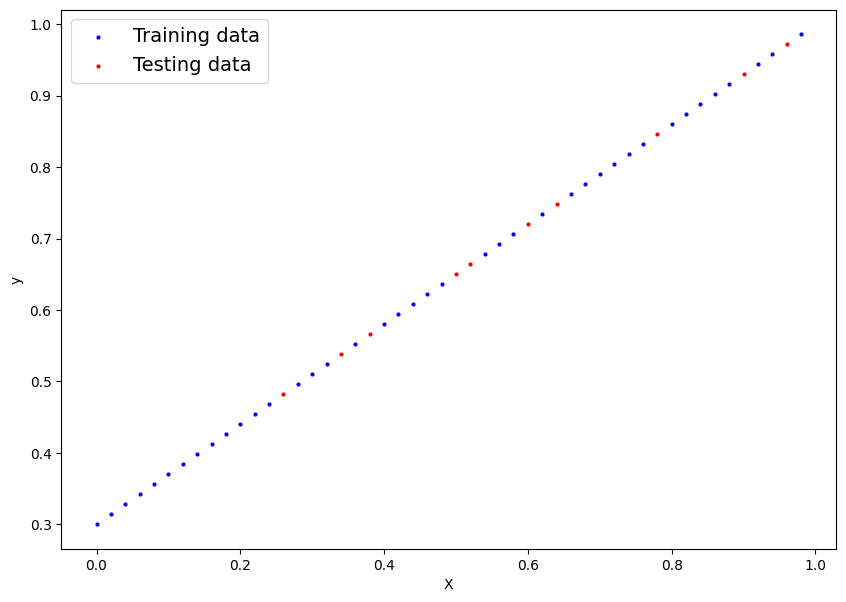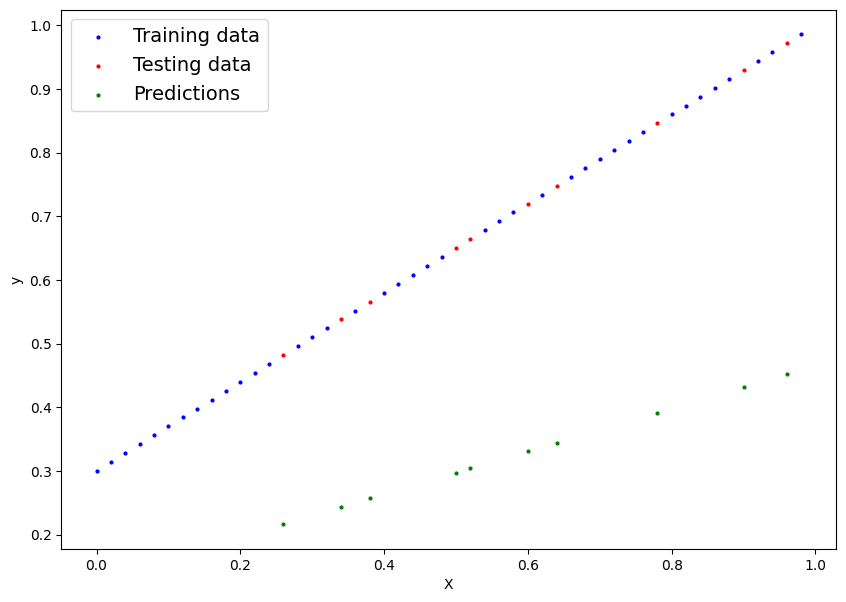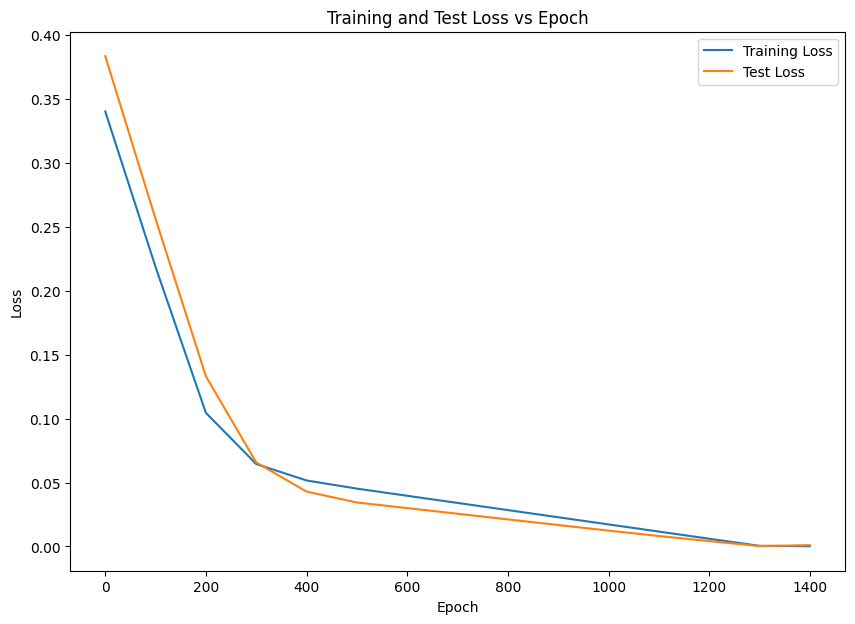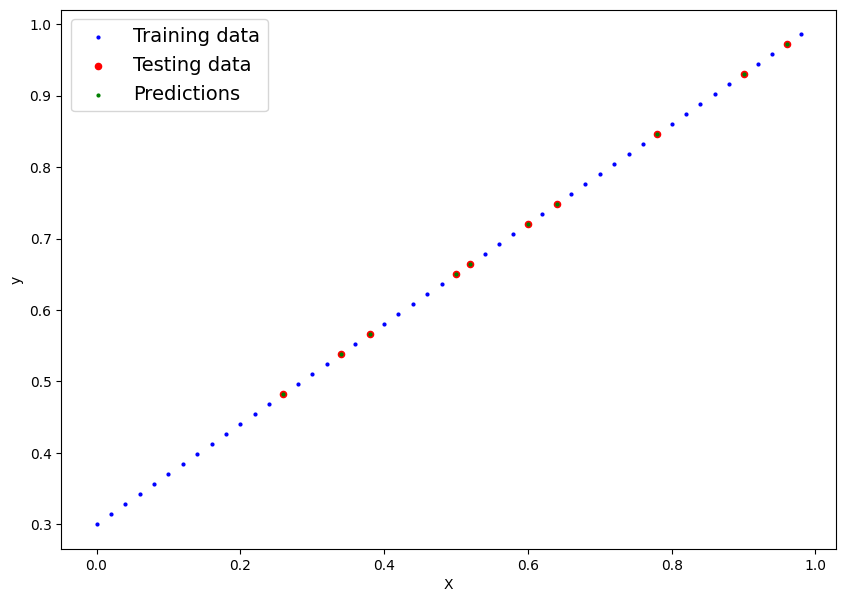Hello PyTorch
Published:
The objective is to use the very basic example of linear regression and use PyTorch to build a model to demonstrate Pytorch workflow and its fundementals.
I will develop a simple model using Pytorch and they use a layered NN to perform the same prediction.
import torch
from torch import nn
import matplotlib.pyplot as plt
torch.__version__
'2.4.1+cu121'
Simple linear regression problem
I will use the freecodecamp example which I find very usefull to get into the fundementals. This will try to build a model which trains 2 variables; Bias and weight of a line. We will generate sample data with predefined values of .3 and .7 and train the model based on the sample data which we have generated.
generate sample data
# We will generate data based on the predefined weight and bias. this will generate a sample set of 5 values
weight = .7
bias = .3
start = 0
end = 1
step = .02
X = torch.arange(start, end, step).unsqueeze(dim=1)
print(X.shape)
y = weight * X + bias
X[:5] , y[:5]
torch.Size([50, 1])
(tensor([[0.0000],
[0.0200],
[0.0400],
[0.0600],
[0.0800]]),
tensor([[0.3000],
[0.3140],
[0.3280],
[0.3420],
[0.3560]]))
# prompt: split the data X and y for train and test at random positions
from sklearn.model_selection import train_test_split
X_train, X_test, y_train, y_test = train_test_split(
X, y, test_size=0.2, random_state=42
)
print(f"X_train shape: {X_train.shape}")
print(f"y_train shape: {y_train.shape}")
print(f"X_test shape: {X_test.shape}")
print(f"y_test shape: {y_test.shape}")
X_train shape: torch.Size([40, 1])
y_train shape: torch.Size([40, 1])
X_test shape: torch.Size([10, 1])
y_test shape: torch.Size([10, 1])
Visualize the sample data
# prompt: visualize the X_train, X_test, y_train, y_test
plt.figure(figsize=(10, 7))
plt.scatter(X_train, y_train, c="b", s=4, label="Training data")
plt.scatter(X_test, y_test, c="r", s=4, label="Testing data")
plt.legend(fontsize=14)
plt.xlabel("X")
plt.ylabel("y")
plt.show()

Model Development
So we need to build a model close to the above line and test the model on the red dots and get a result as close to it.
This is developed by inheriting the nn.Module class
Step 1 : initialize the paramters of bias and weight to a random value
Step 2 : Build a model using a custom funcion = X * weight + Bias.
class LinearRegressionModelKFN(nn.Module):
# The objective is to start with a random weight and bias and then usen the pytorch to figure out the best value based on the training data.
# This is done either by gradient decent or Back propogation.
# we have set requires_grad=True
def __init__(self):
super().__init__()
self.weight = nn.Parameter(torch.randn(1, requires_grad=True, dtype=torch.float))
self.bias = nn.Parameter(torch.randn(1, requires_grad=True, dtype=torch.float))
# we need to overide the forward method
def forward(self, x: torch.Tensor) -> torch.Tensor:
return self.weight * x + self.bias
Initial random values of our model
torch.manual_seed(42)
model_0 = LinearRegressionModelKFN()
print(list(model_0.parameters()))
print(model_0.state_dict())
with torch.inference_mode():
y_preds = model_0(X_test)
y_preds
[Parameter containing:
tensor([0.3367], requires_grad=True), Parameter containing:
tensor([0.1288], requires_grad=True)]
OrderedDict([('weight', tensor([0.3367])), ('bias', tensor([0.1288]))])
tensor([[0.2163],
[0.3914],
[0.3308],
[0.4318],
[0.2433],
[0.4520],
[0.3039],
[0.2972],
[0.3443],
[0.2568]])
Ploting the initial model with random parameters
We need to use pytorch to bring the green line as close to the red line
# prompt: add to the plt the y_preds
plt.figure(figsize=(10, 7))
plt.scatter(X_train, y_train, c="b", s=4, label="Training data")
plt.scatter(X_test, y_test, c="r", s=4, label="Testing data")
plt.scatter(X_test, y_preds, c="g", s=4, label="Predictions")
plt.legend(fontsize=14)
plt.xlabel("X")
plt.ylabel("y")
plt.show()

Pytorch Workflow
We will define a loss function and a optimizer and iteratively use them to enhance the model by reducing the loss function.
We will also track the progress of the loss function
# prompt: set a lossfunction using L1Loss and a Optimizer using SGD
loss_fn = nn.L1Loss()
optimizer = torch.optim.SGD(params = model_0.parameters(), lr=0.001)
# variable as used to iterate the number of time.
epochs = 1500
# Below variables are used to track the progress
epoch_values = []
loss_values = []
test_loss_values = []
# Workflow
for epoch in range(epochs):
# set the model into training mode
model_0.train()
# Step 1: Forward Pass
y_preds = model_0(X_train)
# Step 2: Calculate the loss
loss = loss_fn(y_preds, y_train)
# Step 3: Opimizer zero grad to reset every loop
optimizer.zero_grad()
# Step 4: Perform back propogation
loss.backward()
# Step 5: Step the optimizer
optimizer.step()
# Progress tracking
if epoch % 100 == 0:
print(f"Epoch: {epoch} | Loss: {loss}")
model_0.eval()
print(model_0.state_dict())
with torch.inference_mode():
test_preds = model_0(X_test)
test_loss = loss_fn(test_preds, y_test)
epoch_values.append(epoch)
loss_values.append(loss.detach().numpy())
test_loss_values.append(test_loss.detach().numpy())
Epoch: 0 | Loss: 0.340311199426651
OrderedDict([('weight', tensor([0.3372])), ('bias', tensor([0.1298]))])
Epoch: 100 | Loss: 0.21864144504070282
OrderedDict([('weight', tensor([0.3837])), ('bias', tensor([0.2298]))])
Epoch: 200 | Loss: 0.10451823472976685
OrderedDict([('weight', tensor([0.4301])), ('bias', tensor([0.3256]))])
Epoch: 300 | Loss: 0.06448396295309067
OrderedDict([('weight', tensor([0.4709])), ('bias', tensor([0.3713]))])
Epoch: 400 | Loss: 0.05163732171058655
OrderedDict([('weight', tensor([0.5030])), ('bias', tensor([0.3857]))])
Epoch: 500 | Loss: 0.045265451073646545
OrderedDict([('weight', tensor([0.5278])), ('bias', tensor([0.3827]))])
Epoch: 600 | Loss: 0.03966418653726578
OrderedDict([('weight', tensor([0.5492])), ('bias', tensor([0.3727]))])
Epoch: 700 | Loss: 0.03406292945146561
OrderedDict([('weight', tensor([0.5707])), ('bias', tensor([0.3627]))])
Epoch: 800 | Loss: 0.028461668640375137
OrderedDict([('weight', tensor([0.5921])), ('bias', tensor([0.3527]))])
Epoch: 900 | Loss: 0.02286040410399437
OrderedDict([('weight', tensor([0.6136])), ('bias', tensor([0.3427]))])
Epoch: 1000 | Loss: 0.0172591470181942
OrderedDict([('weight', tensor([0.6351])), ('bias', tensor([0.3327]))])
Epoch: 1100 | Loss: 0.011657887138426304
OrderedDict([('weight', tensor([0.6565])), ('bias', tensor([0.3227]))])
Epoch: 1200 | Loss: 0.006066909525543451
OrderedDict([('weight', tensor([0.6776])), ('bias', tensor([0.3121]))])
Epoch: 1300 | Loss: 0.0004846327065024525
OrderedDict([('weight', tensor([0.6984])), ('bias', tensor([0.3009]))])
Epoch: 1400 | Loss: 0.00019141807570122182
OrderedDict([('weight', tensor([0.7002])), ('bias', tensor([0.3009]))])
Plotting the progress tracking
# prompt: Plot to compare epoch_values with loss_values and test_loss_values
plt.figure(figsize=(10, 7))
plt.plot(epoch_values, loss_values, label="Training Loss")
plt.plot(epoch_values, test_loss_values, label="Test Loss")
plt.xlabel("Epoch")
plt.ylabel("Loss")
plt.title("Training and Test Loss vs Epoch")
plt.legend()
plt.show()

Plotting the model output predictions
# prompt: plot the new y_preds along with the Xtrain and X test
model_0.eval()
print(model_0.state_dict())
with torch.inference_mode():
y_preds = model_0(X_test)
plt.figure(figsize=(10, 7))
plt.scatter(X_train, y_train, c="b", s=4, label="Training data")
plt.scatter(X_test, y_test, c="r", s=20, label="Testing data")
plt.scatter(X_test, y_preds, c="g", s=4, label="Predictions")
plt.legend(fontsize=14)
plt.xlabel("X")
plt.ylabel("y")
plt.show()
OrderedDict([('weight', tensor([0.6998])), ('bias', tensor([0.2999]))])

2 layered NN
# prompt: Create a new model which will perform the same but using a 2 layered nueral network
# Define a two-layer linear regression model
class LinearRegressionModelKFN2Layer(nn.Module):
def __init__(self):
"""
Constructor for the LinearRegressionModelKFN2Layer class. This initializes a simple neural
network with two linear layers. The first linear layer transforms the input with one feature
into a hidden layer with 10 neurons. The second linear layer transforms the hidden layer's
output into a single value (the predicted output).
"""
super().__init__()
# Define the first linear layer (input layer), which takes 1 feature and outputs 10 neurons
self.linear1 = nn.Linear(1, 10)
# Define the second linear layer (output layer), which takes 10 neurons as input and outputs 1 value
self.linear2 = nn.Linear(10, 1)
def forward(self, x):
"""
Forward pass through the neural network. This method takes the input `x`, applies the first
linear transformation, passes it through the ReLU activation function, and then applies the
second linear transformation to get the output.
Args:
x (Tensor): Input tensor containing the feature(s), where each row is an example and
each column is a feature (for this case, there is 1 feature per example).
Returns:
Tensor: The output of the model, which is the predicted value.
"""
# Apply the first linear layer, followed by a ReLU activation function
x = torch.relu(self.linear1(x))
# Apply the second linear layer to get the final output (predicted value)
x = self.linear2(x)
return x
torch.manual_seed(42)
model_2layer = LinearRegressionModelKFN2Layer()
print(list(model_2layer.parameters()))
print(model_2layer.state_dict())
OrderedDict([('linear1.weight', tensor([[ 0.7645],
[ 0.8300],
[-0.2343],
[ 0.9186],
[-0.2191],
[ 0.2018],
[-0.4869],
[ 0.5873],
[ 0.8815],
[-0.7336]])), ('linear1.bias', tensor([ 0.8692, 0.1872, 0.7388, 0.1354, 0.4822, -0.1412, 0.7709, 0.1478,
-0.4668, 0.2549])), ('linear2.weight', tensor([[-0.1457, -0.0371, -0.1284, 0.2098, -0.2496, -0.1458, -0.0893, -0.1901,
0.0298, -0.3123]])), ('linear2.bias', tensor([0.2856]))])
with torch.inference_mode():
y_preds = model_2layer(X_test)
y_preds
# ### Ploting the initial model with random parameters
#
# We need to use pytorch to bring the green line as close to the red line
plt.figure(figsize=(10, 7))
plt.scatter(X_train, y_train, c="b", s=4, label="Training data")
plt.scatter(X_test, y_test, c="r", s=4, label="Testing data")
plt.scatter(X_test, y_preds, c="g", s=4, label="Predictions")
plt.legend(fontsize=14)
plt.xlabel("X")
plt.ylabel("y")
plt.show()
# ## Pytorch Workflow
#
# We will define a loss function and a optimizer and iteratively use them to enhance the model by reducing the loss function.
#
# We will also track the progress of the loss function
loss_fn = nn.L1Loss()
optimizer = torch.optim.SGD(params = model_2layer.parameters(), lr=0.001)
# variable as used to iterate the number of time.
epochs = 1500
# Below variables are used to track the progress
epoch_values = []
loss_values = []
test_loss_values = []
# Workflow
for epoch in range(epochs):
# set the model into training mode
model_2layer.train()
# Step 1: Forward Pass
y_preds = model_2layer(X_train)
# Step 2: Calculate the loss
loss = loss_fn(y_preds, y_train)
# Step 3: Opimizer zero grad to reset every loop
optimizer.zero_grad()
# Step 4: Perform back propogation
loss.backward()
# Step 5: Step the optimizer
optimizer.step()
# Progress tracking
if epoch % 100 == 0:
print(f"Epoch: {epoch} | Loss: {loss}")
model_2layer.eval()
print(model_2layer.state_dict())
with torch.inference_mode():
test_preds = model_2layer(X_test)
test_loss = loss_fn(test_preds, y_test)
epoch_values.append(epoch)
loss_values.append(loss.detach().numpy())
test_loss_values.append(test_loss.detach().numpy())
# ### Plotting the progress tracking
plt.figure(figsize=(10, 7))
plt.plot(epoch_values, loss_values, label="Training Loss")
plt.plot(epoch_values, test_loss_values, label="Test Loss")
plt.xlabel("Epoch")
plt.ylabel("Loss")
plt.title("Training and Test Loss vs Epoch")
plt.legend()
plt.show()
# Plotting the model output predictions
model_2layer.eval()
print(model_2layer.state_dict())
with torch.inference_mode():
y_preds = model_2layer(X_test)
plt.figure(figsize=(10, 7))
plt.scatter(X_train, y_train, c="b", s=4, label="Training data")
plt.scatter(X_test, y_test, c="r", s=20, label="Testing data")
plt.scatter(X_test, y_preds, c="g", s=4, label="Predictions")
plt.legend(fontsize=14)
plt.xlabel("X")
plt.ylabel("y")
plt.show()
Epoch: 0 | Loss: 0.7426110506057739
OrderedDict([('linear1.weight', tensor([[ 0.7645],
[ 0.8300],
[-0.2343],
[ 0.9187],
[-0.2192],
[ 0.2018],
[-0.4869],
[ 0.5872],
[ 0.8816],
[-0.7336]])), ('linear1.bias', tensor([ 0.8691, 0.1871, 0.7387, 0.1356, 0.4819, -0.1412, 0.7708, 0.1476,
-0.4668, 0.2548])), ('linear2.weight', tensor([[-0.1445, -0.0365, -0.1278, 0.2103, -0.2492, -0.1458, -0.0888, -0.1897,
0.0299, -0.3123]])), ('linear2.bias', tensor([0.2866]))])
Epoch: 100 | Loss: 0.3070870339870453
OrderedDict([('linear1.weight', tensor([[ 0.7606],
[ 0.8296],
[-0.2388],
[ 0.9298],
[-0.2300],
[ 0.1985],
[-0.4898],
[ 0.5793],
[ 0.8827],
[-0.7356]])), ('linear1.bias', tensor([ 0.8606, 0.1863, 0.7290, 0.1595, 0.4588, -0.1451, 0.7646, 0.1307,
-0.4653, 0.2424])), ('linear2.weight', tensor([[-0.0226, 0.0207, -0.0655, 0.2680, -0.2127, -0.1451, -0.0348, -0.1487,
0.0390, -0.3068]])), ('linear2.bias', tensor([0.3866]))])
Epoch: 200 | Loss: 0.06249262019991875
OrderedDict([('linear1.weight', tensor([[ 0.7616],
[ 0.8314],
[-0.2406],
[ 0.9416],
[-0.2381],
[ 0.1956],
[-0.4904],
[ 0.5740],
[ 0.8842],
[-0.7358]])), ('linear1.bias', tensor([ 0.8615, 0.1886, 0.7262, 0.1766, 0.4467, -0.1485, 0.7634, 0.1225,
-0.4633, 0.2418])), ('linear2.weight', tensor([[ 0.0595, 0.0654, -0.0317, 0.3158, -0.1951, -0.1445, -0.0089, -0.1178,
0.0481, -0.3070]])), ('linear2.bias', tensor([0.4463]))])
Epoch: 300 | Loss: 0.04238714650273323
OrderedDict([('linear1.weight', tensor([[ 0.7631],
[ 0.8331],
[-0.2414],
[ 0.9491],
[-0.2426],
[ 0.1930],
[-0.4908],
[ 0.5714],
[ 0.8860],
[-0.7339]])), ('linear1.bias', tensor([ 0.8610, 0.1881, 0.7264, 0.1744, 0.4481, -0.1514, 0.7636, 0.1233,
-0.4610, 0.2542])), ('linear2.weight', tensor([[ 0.0711, 0.0832, -0.0422, 0.3363, -0.2036, -0.1441, -0.0254, -0.1056,
0.0574, -0.3124]])), ('linear2.bias', tensor([0.4395]))])
Epoch: 400 | Loss: 0.02345609851181507
OrderedDict([('linear1.weight', tensor([[ 0.7647],
[ 0.8351],
[-0.2424],
[ 0.9565],
[-0.2471],
[ 0.1906],
[-0.4915],
[ 0.5693],
[ 0.8881],
[-0.7319]])), ('linear1.bias', tensor([ 0.8602, 0.1871, 0.7269, 0.1709, 0.4502, -0.1541, 0.7639, 0.1243,
-0.4582, 0.2670])), ('linear2.weight', tensor([[ 0.0789, 0.0992, -0.0547, 0.3550, -0.2134, -0.1438, -0.0436, -0.0946,
0.0669, -0.3183]])), ('linear2.bias', tensor([0.4295]))])
Epoch: 500 | Loss: 0.011140111833810806
OrderedDict([('linear1.weight', tensor([[ 0.7661],
[ 0.8368],
[-0.2434],
[ 0.9625],
[-0.2507],
[ 0.1885],
[-0.4924],
[ 0.5678],
[ 0.8901],
[-0.7297]])), ('linear1.bias', tensor([ 0.8597, 0.1864, 0.7273, 0.1684, 0.4517, -0.1565, 0.7643, 0.1249,
-0.4556, 0.2766])), ('linear2.weight', tensor([[ 0.0856, 0.1118, -0.0637, 0.3697, -0.2206, -0.1436, -0.0570, -0.0860,
0.0761, -0.3215]])), ('linear2.bias', tensor([0.4226]))])
Epoch: 600 | Loss: 0.009158110246062279
OrderedDict([('linear1.weight', tensor([[ 0.7665],
[ 0.8374],
[-0.2438],
[ 0.9645],
[-0.2518],
[ 0.1867],
[-0.4927],
[ 0.5673],
[ 0.8914],
[-0.7283]])), ('linear1.bias', tensor([ 0.8594, 0.1861, 0.7275, 0.1673, 0.4524, -0.1584, 0.7644, 0.1252,
-0.4545, 0.2782])), ('linear2.weight', tensor([[ 0.0870, 0.1156, -0.0672, 0.3743, -0.2233, -0.1434, -0.0619, -0.0834,
0.0832, -0.3196]])), ('linear2.bias', tensor([0.4195]))])
Epoch: 700 | Loss: 0.008464774116873741
OrderedDict([('linear1.weight', tensor([[ 0.7666],
[ 0.8376],
[-0.2439],
[ 0.9650],
[-0.2522],
[ 0.1852],
[-0.4928],
[ 0.5672],
[ 0.8922],
[-0.7273]])), ('linear1.bias', tensor([ 0.8593, 0.1859, 0.7276, 0.1668, 0.4527, -0.1601, 0.7645, 0.1253,
-0.4539, 0.2768])), ('linear2.weight', tensor([[ 0.0870, 0.1166, -0.0685, 0.3754, -0.2243, -0.1432, -0.0636, -0.0828,
0.0891, -0.3161]])), ('linear2.bias', tensor([0.4182]))])
Epoch: 800 | Loss: 0.007900995202362537
OrderedDict([('linear1.weight', tensor([[ 0.7667],
[ 0.8376],
[-0.2439],
[ 0.9652],
[-0.2522],
[ 0.1838],
[-0.4928],
[ 0.5672],
[ 0.8930],
[-0.7265]])), ('linear1.bias', tensor([ 0.8593, 0.1859, 0.7276, 0.1666, 0.4528, -0.1615, 0.7646, 0.1253,
-0.4535, 0.2745])), ('linear2.weight', tensor([[ 0.0868, 0.1168, -0.0690, 0.3757, -0.2246, -0.1431, -0.0642, -0.0826,
0.0945, -0.3122]])), ('linear2.bias', tensor([0.4177]))])
Epoch: 900 | Loss: 0.007354866713285446
OrderedDict([('linear1.weight', tensor([[ 0.7667],
[ 0.8376],
[-0.2439],
[ 0.9652],
[-0.2523],
[ 0.1828],
[-0.4928],
[ 0.5672],
[ 0.8938],
[-0.7257]])), ('linear1.bias', tensor([ 0.8592, 0.1858, 0.7277, 0.1664, 0.4529, -0.1626, 0.7646, 0.1254,
-0.4530, 0.2722])), ('linear2.weight', tensor([[ 0.0865, 0.1169, -0.0694, 0.3758, -0.2249, -0.1430, -0.0647, -0.0826,
0.0999, -0.3083]])), ('linear2.bias', tensor([0.4171]))])
Epoch: 1000 | Loss: 0.00681077316403389
OrderedDict([('linear1.weight', tensor([[ 0.7667],
[ 0.8377],
[-0.2439],
[ 0.9654],
[-0.2524],
[ 0.1818],
[-0.4928],
[ 0.5671],
[ 0.8947],
[-0.7249]])), ('linear1.bias', tensor([ 0.8592, 0.1857, 0.7277, 0.1662, 0.4530, -0.1637, 0.7646, 0.1254,
-0.4526, 0.2699])), ('linear2.weight', tensor([[ 0.0863, 0.1170, -0.0699, 0.3760, -0.2252, -0.1430, -0.0653, -0.0825,
0.1053, -0.3044]])), ('linear2.bias', tensor([0.4166]))])
Epoch: 1100 | Loss: 0.006268690340220928
OrderedDict([('linear1.weight', tensor([[ 0.7667],
[ 0.8377],
[-0.2439],
[ 0.9654],
[-0.2524],
[ 0.1808],
[-0.4928],
[ 0.5671],
[ 0.8956],
[-0.7241]])), ('linear1.bias', tensor([ 0.8591, 0.1857, 0.7277, 0.1660, 0.4531, -0.1648, 0.7647, 0.1255,
-0.4521, 0.2676])), ('linear2.weight', tensor([[ 0.0860, 0.1171, -0.0703, 0.3762, -0.2255, -0.1429, -0.0658, -0.0824,
0.1107, -0.3006]])), ('linear2.bias', tensor([0.4161]))])
Epoch: 1200 | Loss: 0.005730263888835907
OrderedDict([('linear1.weight', tensor([[ 0.7667],
[ 0.8377],
[-0.2440],
[ 0.9655],
[-0.2525],
[ 0.1798],
[-0.4928],
[ 0.5671],
[ 0.8965],
[-0.7234]])), ('linear1.bias', tensor([ 0.8591, 0.1856, 0.7278, 0.1658, 0.4533, -0.1658, 0.7647, 0.1255,
-0.4516, 0.2654])), ('linear2.weight', tensor([[ 0.0857, 0.1172, -0.0708, 0.3763, -0.2258, -0.1429, -0.0663, -0.0823,
0.1161, -0.2967]])), ('linear2.bias', tensor([0.4155]))])
Epoch: 1300 | Loss: 0.005442876368761063
OrderedDict([('linear1.weight', tensor([[ 0.7667],
[ 0.8377],
[-0.2439],
[ 0.9653],
[-0.2523],
[ 0.1791],
[-0.4928],
[ 0.5671],
[ 0.8974],
[-0.7227]])), ('linear1.bias', tensor([ 0.8591, 0.1856, 0.7278, 0.1657, 0.4533, -0.1665, 0.7647, 0.1255,
-0.4511, 0.2630])), ('linear2.weight', tensor([[ 0.0851, 0.1166, -0.0707, 0.3757, -0.2257, -0.1429, -0.0661, -0.0827,
0.1208, -0.2928]])), ('linear2.bias', tensor([0.4154]))])
Epoch: 1400 | Loss: 0.00519354036077857
OrderedDict([('linear1.weight', tensor([[ 0.7666],
[ 0.8375],
[-0.2438],
[ 0.9649],
[-0.2521],
[ 0.1785],
[-0.4927],
[ 0.5672],
[ 0.8983],
[-0.7218]])), ('linear1.bias', tensor([ 0.8591, 0.1856, 0.7278, 0.1658, 0.4532, -0.1672, 0.7647, 0.1255,
-0.4502, 0.2613])), ('linear2.weight', tensor([[ 0.0847, 0.1159, -0.0703, 0.3748, -0.2253, -0.1428, -0.0654, -0.0832,
0.1242, -0.2893]])), ('linear2.bias', tensor([0.4157]))])
OrderedDict([('linear1.weight', tensor([[ 0.7666],
[ 0.8375],
[-0.2438],
[ 0.9649],
[-0.2521],
[ 0.1780],
[-0.4927],
[ 0.5672],
[ 0.8993],
[-0.7209]])), ('linear1.bias', tensor([ 0.8591, 0.1857, 0.7277, 0.1660, 0.4531, -0.1677, 0.7646, 0.1254,
-0.4491, 0.2602])), ('linear2.weight', tensor([[ 0.0851, 0.1160, -0.0699, 0.3749, -0.2251, -0.1428, -0.0649, -0.0832,
0.1279, -0.2860]])), ('linear2.bias', tensor([0.4163]))])
